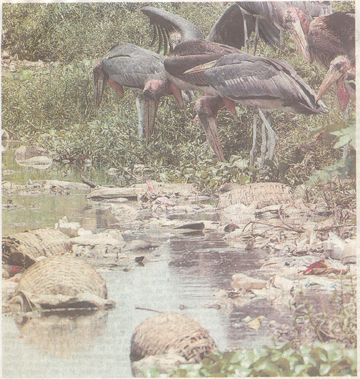CiviC Disobedience
--Shivani Thakur
Mahatma Gandhi, in 1915 while visiting banks of river Ganga, was agonized to see people performing natural functions on the thoroughfares and
riverbanks. But much hasn’t changed since. Every year the monsoons bring with them diseases like gastroenteritis, cholera, dengue, typhoid, dengue, and influenza. The recent deaths of about 20 people in Mumbai was due to outbreak of
such diseases. Open garbage dumps; untreated sewage, clogged drains and no clean drinking water are the root causes.
The cities and metros with sprawling malls and rising skyscrapers are incapable of handling basic sanitation requirements. Only 30% of wastewater is treated before disposal. Most sewage water empties into open drains or rivers. The sewage system works
on obsolete methods putting pressure on the already clogged drains resulting in spillage of sewerage in the open.
In the slums the problems are worsened. A 2005 World Bank report pointed out that a “chronic lack of urban sanitation policy and planning activity has made a major contribution to lack of progress.”
Also, this untreated or partially treated wastewater seeps into the rivers, lakes and groundwater leading to increasing incidence of diseases.
Not only water, the food available in shops like cakes, pastries, sweets, milk etc can be tracked down to slums where most basic ingredients are made for these.
The dairy farms run the risk of contamination because of no proper drainage of waste and manure disposal system .The atta chakkis are infested with rodents and are in pathetic condition.
Small poultry farmers let hens feed near open drains.
Bigger farms with closed enclosures have stale food, excreta or dead birds making them filthy and unhygienic.
In rural areas open defecation is still the norm with only 22%households having access to basic sanitation facilities. This is largely due to old mindset of the people. Inspite of launch of Central Rural Sanitation Programme(CRSP) in 1986,with 100% subsidy
to people for constuction of toilets, it was a complete failure.
In 1999 CRSP was scraped to be replaced by a new drive called Total Sanitary Campaign to bring sanitation through information, education and communication. Though about 2.8 million households are added annually yet they are far from adequate.
According to the World Bank report it will be by 2024 that India will achieve full household toilet coverage in rural India.
But India has some feathers in its cap like in
Nandigram-II in West Bengal where 100% sanitation has been achieved. This improved both the community surroundings and health.
In 2003 the Thandavampatti hamlet in Tamil Nadu became the first rural habitation to be declared open defecation free.
In Mumbai’s Dharavi, Asia’s biggest slum, caste based scavengers have found a better vocation by managing public toilets for a monthly salary.
The “sulabh shauchalaya” scheme allows petty traders, laborers, domestic workers to use public facilities for a miniscule amount of one rupee.
There is a growing need to create awareness on the proper usage of sanitation facilities as well as to educate people not only in rural areas but cities too so as to transform their lives and help control outbreak of diseases.

A group of Greater Adjutant storks look for food in a polluted wetland area in Guwahati.
Lack of proper garbage dumping facilities in the city is endangering the environment as well as wildlife.
This photo by Ritu Raj Konwar appeared in
The Hindu of June 6, 2004